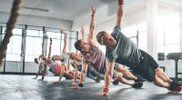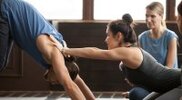V
vkim
Guest
Some people are born with flexibility while others have to work for it. And no matter what category you fall under, gaining a greater range of motion, both in muscles and joints, takes persistence and time.
Stretching plays an important role in keeping the body flexible and has even been known to aid in injury prevention. However, if you find it boring, or simply forget to stretch before and after workouts, there are a handful of methods in which you can keep your body limber. Here, Holly McGrath, NASM, CPT, owner of C3 Lifestyle at Core Connection Confidence shares the importance of owning flexibility while sharing ways in which you can gain both mobility and flexibility that doesn’t involve stretching class.
Although both flexibility and mobility are both important components in helping develop a greater range of motion, it’s the areas of the body they impact that differentiate them.
Simply put, mobility has to do with the joints while flexibility deals with the muscles.

People Images / Getty
“Flexibility, both in terms of physical and mental adaptability, offers a wide range of benefits that can enhance various aspects of your life,” explains McGrath.
Here are some of the key advantages of being flexible:
1. Improved Physical Health:
2. Enhanced Athletic Performance:
3. Stress Reduction:
4. Healthier Aging:

PeopleImages
Beyond the common toe touch touches, McGrath explains there are ways to self-test your flexibility and mobility. Here, she asks these questions to help you access them.
If you answer yes to any of these questions, you may have tightness that needs to be addressed.
Good to Know: This may vary within a population or due to other disorders such as EDS or Hypermobility Spectrum Disorder. Pregnancy and nursing can also affect the body’s ability to stretch and should be taken into consideration to avoid overstretching, causing potential injury.

fizkes / Shutterstock
For the days you don’t feel like stretching, McGrath shares all the ways you can develop a greater range of motion.
Keep in Mind: McGrath stresses to always prioritize safety when working on flexibility. “Avoid overstretching, and if you’re new to stretching routines, consider consulting a fitness professional or physical therapist to create a personalized plan that suits your needs and goals.”
“Lack of flexibility can lead to various physical and functional issues,” shares McGrath. She gives us a closer look at the potential dangers of lack of flexibility. Remember these next time you feel like skipping out on ROM work:
McGrath notes that it’s important to understand that flexibility varies from person to person, and some level of natural inflexibility is normal. “However, regularly incorporating stretching and flexibility exercises into your routine can help mitigate these dangers and improve your overall physical health and well-being.” After all, taking the time to invest in your physical health is never a waste of time and the benefits are worth it.

Workout Routines
Keep the iron on the rack and train using just your bodyweight.
Read article
Continue reading...
Stretching plays an important role in keeping the body flexible and has even been known to aid in injury prevention. However, if you find it boring, or simply forget to stretch before and after workouts, there are a handful of methods in which you can keep your body limber. Here, Holly McGrath, NASM, CPT, owner of C3 Lifestyle at Core Connection Confidence shares the importance of owning flexibility while sharing ways in which you can gain both mobility and flexibility that doesn’t involve stretching class.
The Difference Between Flexibility and Mobility
Although both flexibility and mobility are both important components in helping develop a greater range of motion, it’s the areas of the body they impact that differentiate them.
Simply put, mobility has to do with the joints while flexibility deals with the muscles.
Flexibility is the ability of the muscles to lengthen fully.
Mobility is the ability of joints to move freely through a full range of motion without discomfort.

People Images / Getty
Benefits of Flexibility
“Flexibility, both in terms of physical and mental adaptability, offers a wide range of benefits that can enhance various aspects of your life,” explains McGrath.
Here are some of the key advantages of being flexible:
1. Improved Physical Health:
- Reduced Risk of Injury: Flexible muscles and joints are less prone to strain and injury during physical activities.
- Better Posture: Flexibility can help maintain proper posture, reducing the risk of musculoskeletal problems.
- The act of stretching can help interrupt the nervous system to help manage/relieve chronic pain.
2. Enhanced Athletic Performance:
- Greater Range of Motion: Improved flexibility allows athletes to move more freely, increases agility, and helps to optimize strength training, potentially improving their performance in sports and physical activities.
- Faster Recovery: Flexible muscles tend to recover more quickly after strenuous exercise.
3. Stress Reduction:
- Mindfulness: Flexible individuals often find it easier to engage in mindfulness practices, such as meditation and yoga.
4. Healthier Aging:
- Reduced Stiffness: Maintaining physical flexibility as you age can lead to greater comfort and mobility in daily life.
- Can help manage pain which would improve quality of life.

PeopleImages
How to Self-Test Your Flexibility and Mobility
Beyond the common toe touch touches, McGrath explains there are ways to self-test your flexibility and mobility. Here, she asks these questions to help you access them.
If you answer yes to any of these questions, you may have tightness that needs to be addressed.
- Do you have pain or discomfort when performing the lying hamstring stretch? (If a leg is positioned at 90 degrees and if there is discomfort getting there, you may have tight hamstrings).
- Can you reach your arm straight overhead towards the ceiling without excessive back arching or pain/discomfort?
- Can you look over your shoulder while backing in and/or out of your car?
- Are there certain activities you used to do that are now hard for you to do or cause pain/discomfort? This will indicate where you may be losing flexibility and mobility.
Good to Know: This may vary within a population or due to other disorders such as EDS or Hypermobility Spectrum Disorder. Pregnancy and nursing can also affect the body’s ability to stretch and should be taken into consideration to avoid overstretching, causing potential injury.

fizkes / Shutterstock
All The Ways You Can Gain Flexibility (and Mobility)
For the days you don’t feel like stretching, McGrath shares all the ways you can develop a greater range of motion.
- Regular Stretching Routine: Dedicate time to stretching exercises daily or several times a week, focusing on all major muscle groups.
- Strength Training with proper form: This will increase your flexibility as time goes on and you increase your range of motion. (i.e., deadlifts stretch hamstrings, biceps curls with full extension stretch biceps, overhead press will stretch lats and shoulders).
- Dynamic Stretching & Mobility: Incorporate dynamic stretches like leg swings, floor swings, or arm circles into your warm-up routine before exercise to increase mobility. Along with mobility exercises such as CARs and other dynamic movements.
- Yoga: Practice yoga, as it combines stretching, balance, and mindfulness to promote flexibility and overall well-being.
- Pilates: Engage in Pilates exercises that strengthen your core and improve flexibility, particularly in the spine and limbs.
- Foam Roller: Use a foam roller for self-myofascial release, which can help relieve the nervous system tension, create blood flow, and enhance mobility.
- Stay Active: Engage in regular physical activities like walking, swimming, or cycling, as staying active can maintain and improve flexibility. “If you don’t use it, you lose it.”
- Proper Nutrition: Consume a balanced diet rich in vitamins and minerals, which supports muscle health and flexibility.
- Hydration: Stay well-hydrated to prevent muscle stiffness and cramping, which can hinder flexibility progress.
Keep in Mind: McGrath stresses to always prioritize safety when working on flexibility. “Avoid overstretching, and if you’re new to stretching routines, consider consulting a fitness professional or physical therapist to create a personalized plan that suits your needs and goals.”
Why You Shouldn’t Ignore Limited Range of Motion
“Lack of flexibility can lead to various physical and functional issues,” shares McGrath. She gives us a closer look at the potential dangers of lack of flexibility. Remember these next time you feel like skipping out on ROM work:
- Increased Risk of Injury: Inflexible muscles and joints are more prone to strains, sprains, and tears during physical activities. This can affect both athletes and everyday individuals.
- Muscle Imbalances: Limited flexibility can lead to muscle imbalances, where some muscles are excessively tight while others are weak. This imbalance can result in poor posture and chronic pain.
- Reduced Range of Motion: Restricted flexibility can limit your ability to move your joints through their full range of motion, making everyday activities more challenging.
- Postural Problems: Poor flexibility can contribute to bad posture, leading to discomfort, pain, and long-term musculoskeletal issues, including conditions like kyphosis or lordosis.
- Joint Issues: Limited flexibility and mobility can increase the risk of joint problems such as arthritis, as it can lead to uneven wear and tear on the joints.
- Back Pain: Tight hamstrings and hip flexors, common in individuals with limited flexibility, can contribute to chronic lower back pain.
- Reduced Athletic Performance: Athletes with poor flexibility may struggle to perform optimally in their respective sports due to limited mobility and increased injury risk.
- Limited Functional Movement: Everyday tasks like bending, reaching, and lifting become more challenging when you lack flexibility, potentially affecting your quality of life.
- Poor Circulation: Restricted flexibility can impede blood flow, potentially leading to decreased oxygen and nutrient delivery to muscles and tissues.
- Mental Stress: Physical stiffness can contribute to mental stress, as discomfort and pain can affect mood and overall well-being.
McGrath notes that it’s important to understand that flexibility varies from person to person, and some level of natural inflexibility is normal. “However, regularly incorporating stretching and flexibility exercises into your routine can help mitigate these dangers and improve your overall physical health and well-being.” After all, taking the time to invest in your physical health is never a waste of time and the benefits are worth it.

Workout Routines
The Bodyweight Routine for Mobility and Athleticis...
Keep the iron on the rack and train using just your bodyweight.
Read article
Continue reading...

